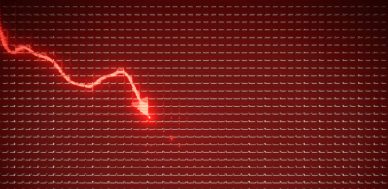Yield Curve Says Recession Ahead for the U.S. Economy
A recession could be nearing for the U.S. economy. Pay very little attention to what has happened in the past few quarters. A key indicator is saying that the U.S. could be headed toward a slowdown.
One indicator that shouldn’t be ignored is the yield curve.
Essentially, a yield curve shows the difference between yields of various government bonds of different maturities. Mind you, long-term readers of Lombardi Letter have been warned about this several times.
You see, yield curves are interesting. Whenever the difference between yields on the 10-year U.S. bonds and the two-year U.S. bonds reaches zero or drops below it, economists see it as a sure sign of a recession.
With that said, look at the chart below. It plots the difference between yields on the 10-year U.S. bonds and the two-year U.S. bonds.
Chart courtesy of StockCharts.com
Over the last one year, the yield curve has continued to drop. It is fast approaching that dangerous “zero” mark.
This indicator has been very powerful in predicting an economic slowdown.
It correctly predicted the last two recessions in the U.S. economy.
So, dear reader, the yield curve could be saying something very critical here.
I know the mainstream media might have you convinced that this is happening because of the Federal Reserve raising its interest rates, but don’t listen too much to that noise.
If the Fed rate hikes are only impacting the short-term bonds, it’s scary. It says investors believe that long-term rates are expected to remain low as well. Low rates are associated with slow growth.
What Happens If There’s Actually a Recession?
I am more concerned about what happens if there really is a recession.
It could have dire consequences across the board.
Americans haven’t really recovered from the previous recession. This upcoming slowdown could throw more gas on the fire.
Americans aren’t really saving much.
Look at the chart below. It plots the year-over-year percentage change in total savings deposits at banks each quarter.
(Source: “Total Savings Deposits at all Depository Institutions,” Federal Reserve Bank Of St. Louis, last accessed August 27, 2018.)
Americans were putting money into savings accounts in early 2018—savings deposits were growing by over 17%. In the second quarter of 2018, this rate tumbled to just 2.5%.
What happens if the U.S. economy faces headwinds and there are a lot of job cuts? If Americans haven’t been saving much, will they spend in times when they don’t have any income?
A lot of Americans are already struggling. As of May 2018, there were 39.32 million Americans using food stamps. (Source: “Supplemental Nutrition Assistance Program,” United States Department of Agriculture, August 3, 2018.)
If there’s a recession, this figure could increase immensely.
Lastly, know that Americans have put a lot of money in the stock market.
Look at the chart below. It essentially plots the amount of equities Americans hold.
(Source: “Households and nonprofit organizations; corporate equities; asset, Level,” Federal Reserve Bank of St. Louis, last accessed August 27, 2018.)
Since the previous recession, Americans have allocated about $13.0 trillion in stocks.
Remember, stock markets move ahead of the economy. If a slowdown is approaching, Americans’ wealth could be on the line, too.
I will end with this: The U.S. economy could be headed toward a recession, and it won’t be good for Americans.
